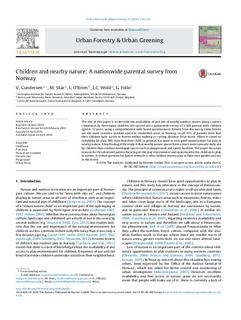| dc.contributor.author | Gundersen, Vegard | |
| dc.contributor.author | Skår, Margrete | |
| dc.contributor.author | O'Brien, Liz | |
| dc.contributor.author | Wold, Line Camilla | |
| dc.contributor.author | Follo, Gro Irene | |
| dc.date.accessioned | 2016-04-27T09:16:32Z | |
| dc.date.accessioned | 2019-02-01T09:04:43Z | |
| dc.date.available | 2016-04-27T09:16:32Z | |
| dc.date.available | 2019-02-01T09:04:43Z | |
| dc.date.issued | 2016 | |
| dc.identifier.citation | Urban Forestry & Urban Greening 2016, 17:116-125 | |
| dc.identifier.issn | 1610-8167 | |
| dc.identifier.uri | http://hdl.handle.net/11250/2583433 | |
| dc.description | - | |
| dc.description.abstract | tThe aim of this paper is to describe the availability of and use of nearby outdoor spaces along a naturecontinuum by Norwegian children. We carried out a nationwide survey of 3 160 parents with childrenaged 6–12 years, using a comprehensive web-based questionnaire. Results from the survey show forestsare the most common outdoor space in residential areas in Norway. In all, 97% of parents state thattheir children have access to forests within walking or cycling distance from home. When it comes tosuitability for play, 88% state that their child, in general, has good or very good opportunities for play innearby nature. A key finding of the study is that nearby nature spaces have a much more sporadic daily useby children than outdoor developed spaces such as playgrounds and sports facilities. The paper discussesreasons for this observed pattern focusing on the play environment and opportunities for children to playin nature. A central question for future research is why children merely play in their own garden and notin the forest.
Childhood Free play Natural environment Outside play Playground Urban forest | |
| dc.language.iso | eng | |
| dc.title | Children and nearby nature: A nationwide parental survey from Norway | |
| dc.type | Journal article | |
| dc.date.updated | 2016-04-27T09:16:32Z | |
| dc.identifier.doi | 10.1016/j.ufug.2016.04.002 | |
| dc.identifier.cristin | 1352657 | |
| dc.relation.project | Norges forskningsråd: xxxxxx | |
